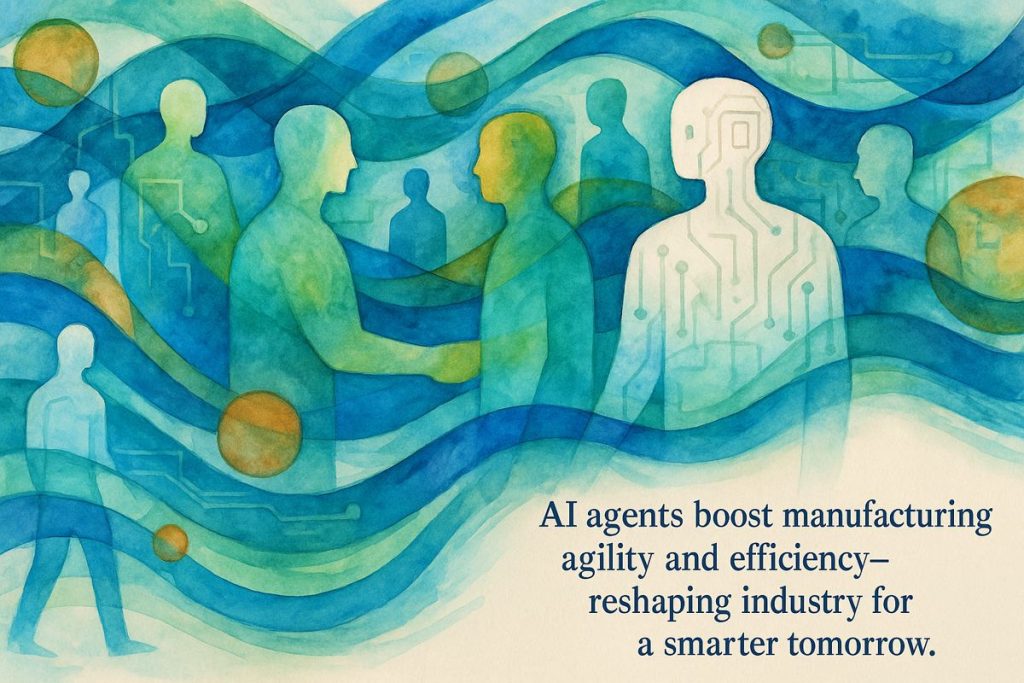AI agents in manufacturing are smart robots or software that use data to make factories run smoother and faster. They predict problems before machines break, make sure products are top-quality, and quickly react if something goes wrong. These agents can learn and adapt, almost like jazz musicians, making factories much more flexible and strong. While they can’t replace people, they help humans make better choices and solve tough problems together. The result is a lively, high-tech factory where both humans and machines work as a smart team.
What are AI agents in manufacturing and how are they transforming the industry?
AI agents in manufacturing are intelligent software or robotic systems that analyze real-time data, adapt to changing conditions, and optimize production processes. They improve efficiency by predicting equipment failures, ensuring quality control, and dynamically managing supply chains, making manufacturing more agile, precise, and resilient.
The Dawn Chorus of Digital Brains
Picture the factory floor: not quite the steampunk fever-dream of clanking gears and hissing pistons, but something altogether subtler, humming with invisible intelligence. By 2025, AI agents have elbowed their way from the ivory tower of theory into the mucky, glorious trenches of manufacturing—think Pfizer’s sterile production suites or the labyrinthine supply chains behind a Tesla Model Y. These agents are more than souped-up calculators; they’re digital palimpsests, constantly rewriting their own logic as they learn from floods of data.
I’ll admit, the first time I watched an AI-driven robot reroute a jammed conveyor belt at an unnamed electronics plant (let’s call it “Monday morning in Munich”), I felt both awe and a twinge of dread. Was I witnessing the dawn of a new industrial epoch or just another dashboard demo destined for PowerPoint limbo? Time (and several espressos) would tell.
If you’re wondering just what separates these agents from their ancestral PLCs or rule-based bots, consider this: AI agents don’t just execute orders, they improvise, adapting to shifting conditions like jazz musicians riffing on a theme—sometimes off-key, sure, but capable of genuine insight.
Anatomy of an Industrial Agent
So, how do these hyperspectral minds-in-machines actually work? Let’s start with some specifics. AI agents in manufacturing operate either as virtual overlays in a system—think Python scripts embedded in a Siemens MindSphere dashboard—or as flesh-and-bolts robots rolling down the aisles of a Procter & Gamble warehouse. Their “brains” synthesize torrents of sensor readings, historical logs, and real-time market signals, forging decisions that can range from the mundane (“swap out that temperature probe, stat”) to the eerily prescient (“shift production to Line 3—supplier X just missed a shipment in Qingdao”).
Here’s where it gets tasty (figuratively, but also with a whiff of burnt solder if you’re onsite): in pharma, AI agents run digital twins, simulating entire vaccine batch processes before a single milliliter of culture medium is poured. In automotive, they orchestrate just-in-time component arrivals, sparing us all from the Kafkaesque nightmare of a stalled assembly line. IBM and ARC Advisory Group have been breathless in their coverage of this paradigm shift, with ARC’s blog chronicling the latest trade-show unveilings in Chicago and Düsseldorf.
Let me share a tiny confession: I once dismissed predictive maintenance as a glorified Excel spreadsheet in a lab coat. That was before I saw a spectral vibration analysis, run by an AI agent, catch a bearing fault two weeks before it would’ve shut down an entire dosing reactor. Bam! Lesson learned—never underestimate the value of a well-timed anomaly flag.
From Adaptation to Agility: Real-World Deployments
Why the sudden acceleration? Two years ago, nearly 70% of major manufacturers had at least one pilot project using AI agents, according to IIoT World.. Today, you’ll find these agents squinting at vision streams in cleanrooms, sniffing out subtle deviations in humidity, or parsing the rhythms of packaging lines like seasoned percussionists.
Consider this: a pharmaceutical plant leverages agents to guarantee that every vial emerging from a filling line is pristine, adhering to regulatory standards with fanatical precision. At the same time, those same agents may trigger a gentle alarm—soft chime, nothing jarring—when an operator’s gowning protocol goes astray, protecting both patient safety and the company’s bottom line.
Meanwhile, in electronics manufacturing, AI agents dynamically reschedule production in response to sudden shortages of tantalum capacitors (those little things that always seem to vanish at the worst possible moment). This agility isn’t just a buzzword—it’s the difference between a smoothly humming supply chain and a million-euro headache. I can almost smell the ozone when lines ramp up without a hitch.
All this doesn’t mean it’s frictionless. There’s a recurring headache: integrating these polymorphic agents with legacy MES and ERP systems. Sometimes, the handshake is less “firm grip” and more “awkward limp noodle.” Still, cloud-based agent platforms are smoothing these wrinkles, as IBM’s insights attest.
The Human Element (or, How I Learned to Stop Worrying and Love the Bot)
Let’s be honest: the rise of AI agents hasn’t eliminated the need for human ingenuity. If anything, it’s made our jobs more interesting—sometimes more baffling, always more dynamic. I had to stop and ask myself after a particularly harrowing product recall (don’t ask, still stings): can a machine really capture the nuances of regulatory risk, or is there always some ineffable, human element? The answer, I suspect, lies somewhere in the messy middle.
There’s joy in watching a cross-disciplinary team—engineers, data scientists, supply chain managers—huddle around a digital dashboard, arguing about the best way to fine-tune an agent’s optimization parameters. Occasionally, there’s frustration, too. Ugh. But as Spiros Margaris quipped at a recent conference, “If you’re not learning from your AI agent, you’re probably not paying attention.”
And sometimes, amidst the whirr of servo motors and the faint tang of isoprop
